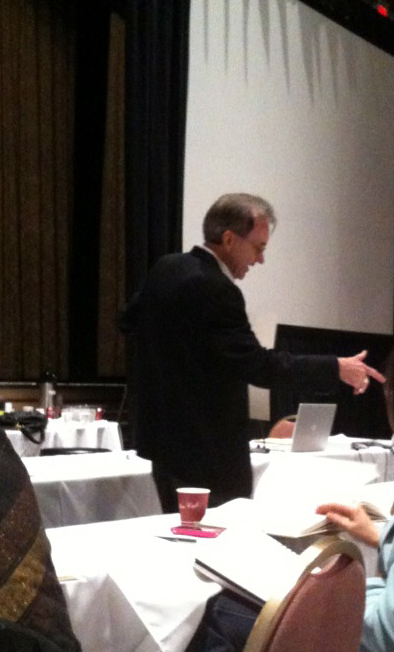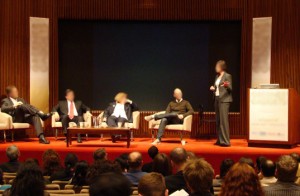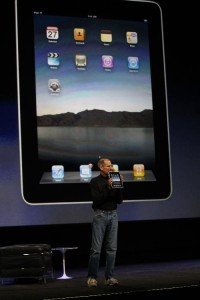 I recently attended Edward Tufte’s full day class “Presenting Data and Information” for the second time. I enjoyed it just as much as the first time and highly recommend it for anyone in the business of designing and producing presentation visuals. If you don’t know who Edward Tufte is, he is the master of Visual Data Design. Last week President Barack Obama announced that he would be appointing Edward Tufte to the independent panel that advises the Recovery Accountability and Transparency Board. Tufte is being asked to help design the government web site www.recovery.gov, which will chart how every single dollar of the $787 billion stimulus bill is being spent. A Newsweek article on his appointment, calls his data visualization “the clearest, richest interactive database ever produced by the American bureaucracy”.
I recently attended Edward Tufte’s full day class “Presenting Data and Information” for the second time. I enjoyed it just as much as the first time and highly recommend it for anyone in the business of designing and producing presentation visuals. If you don’t know who Edward Tufte is, he is the master of Visual Data Design. Last week President Barack Obama announced that he would be appointing Edward Tufte to the independent panel that advises the Recovery Accountability and Transparency Board. Tufte is being asked to help design the government web site www.recovery.gov, which will chart how every single dollar of the $787 billion stimulus bill is being spent. A Newsweek article on his appointment, calls his data visualization “the clearest, richest interactive database ever produced by the American bureaucracy”.
If there is anyone that can take on the monster task of taking the tons of government dollar data of the recovery act and turn it into visually appealing and most important understandable information for a mass audience, it is Tufte. I only wish the government used Tufte or one of his followers to put the healthcare chaotic mess into some easy to understand visuals so the voting public could actually understand what is going on or maybe even help our politicians understand what exactly they really voted for.
Tufte is amazing how he can take a boat load of complicated data and turn it into a simplified, accurate visualization that communicates the data tracking results effectively. In today’s world of infinite information overload, this talent is in high demand. Tufte is well known by anyone in the business of presenting data and information, or at least he should be. Don’t hire any professional presentation designer if they can’t tell you they are familiar with some of Edward Tufte’s principles of data and information design.
Although, be careful of “professional presentation designers” that buy into his anti-PowerPoint message. He spews anti-PowerPoint insults to anyone in his class that admits they use PowerPoint. I believe it has been a great marketing ploy. He broke out of his circle of academic fame into the public eye with his essay “PowerPoint Does Rocket Science–and Better Techniques for Technical Reports” where he claims PowerPoint is partly responsible for the Columbia spaceship disaster. From this essay, the “DEATH by PowerPoint” term was born and the Anti-PowerPoint movement was launched. Data visualization is not by any means an interesting topic of mass appeal, but PowerPoint, the tool of millions, if not nearly every professional and amateur presenter, is an easy target to attract mass appeal. With PowerPoint shows being viewed by millions and millions of audiences around the world every day, every hour, every minute, who can not say they have not viewed more than their fare share of bad PowerPoint slides? Tufte’s “Death by PowerPoint” message hit home to the millions of people who regularly are forced to sit through boring presentations and BAD PowerPoint produced slides.
Yes, I will admit PowerPoint has probably contributed partially to the Columbia Spaceship disaster, but in the same way a knife contributes to the killing in the latest murder on last night’s news. But it is only a tool, you can’t hold the knife responsible for the murder! When used appropriately, a knife can carve a delicious turkey, or help carve a beautiful sculpture. PowerPoint is just a communication tool. In Tufte’s essay all he proves is that the decision makers used the tool wrong or maybe should have used a different tool such as a long detailed technical engineering report and not relied so heavily on summary slides.
In my view, Tufte’s essay actually proves how POWERFUL a PowerPoint presentation can be in shaping opinions and moving people to decisions. Unfortunately in the case of the Columbia incident it was used poorly, and resulted in a bad decision. BAD PowerPoint can lead to bad decisions. It can do this by inaccurately focusing the audience on wrong information and in most cases just “kills” the the communication at the meeting, which almost always results in causing more problems.
PowerPoint can be a great tool when used correctly. I have personally seen it happen hundreds of times – how a good PowerPoint deck has helped communicate critically important messages that have impacted millions of lives for the better by changing the courses of large and small companies for the better. I have seen great presentations with the help of powerful PowerPoint visuals close billion dollar corporate deals and help raise millions of dollars at a single charity event.
Edward Tufte, a data guru, professor with a passion for very large sculptures, you’re famous now. You’re making millions. Please give up on the anti-PowerPoint marketing message and acknowledge the reality that it is just a tool and if you use it well (and this includes using many of your principles of good data visualization), it can be a great tool for presenting data and information. One day maybe you’ll read and agree with my essay “Life by PowerPoint”.

 I recently attended Edward Tufte’s full day class “
I recently attended Edward Tufte’s full day class “ I attended a conference recently that was 50% Panel Discussions vs 50% Presentations. Panel Discussions seem to be part of the “Anti-PowerPoint” trend. I believe the Panel Presentations “trend” is because they are easy to organize, require little planning, ofter exposure to plenty of willing volunteers who claim to be experts in their field, they’re promoted as being more interactive than a “presentation”. And most of all, Panel Discussions at events are a trend, because it’s easier for conference organizers to get people to present on a panel, because they don’t have to fear “Death by PowerPoint”, since most panel discussions I’ve seen lately don’t use PowerPoint slides.
I attended a conference recently that was 50% Panel Discussions vs 50% Presentations. Panel Discussions seem to be part of the “Anti-PowerPoint” trend. I believe the Panel Presentations “trend” is because they are easy to organize, require little planning, ofter exposure to plenty of willing volunteers who claim to be experts in their field, they’re promoted as being more interactive than a “presentation”. And most of all, Panel Discussions at events are a trend, because it’s easier for conference organizers to get people to present on a panel, because they don’t have to fear “Death by PowerPoint”, since most panel discussions I’ve seen lately don’t use PowerPoint slides. a few advantages over your typical presenter such as he wanted better presentation software, so he had Apple develop Keynote. I’d love to know why they never developed a Windows version. A bigger advantage is that he always has a great, exciting, newsworthy product to show and demo. My favorite memorable “Steve the Presenter” moment was pulling the Apple MacBook air out of a inter-office envelope. He’s part marketing magician.
a few advantages over your typical presenter such as he wanted better presentation software, so he had Apple develop Keynote. I’d love to know why they never developed a Windows version. A bigger advantage is that he always has a great, exciting, newsworthy product to show and demo. My favorite memorable “Steve the Presenter” moment was pulling the Apple MacBook air out of a inter-office envelope. He’s part marketing magician.